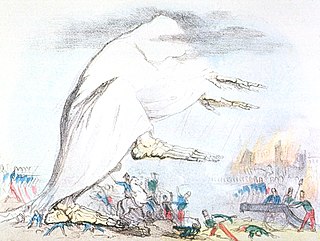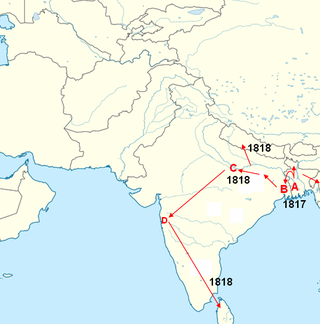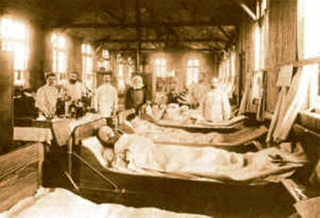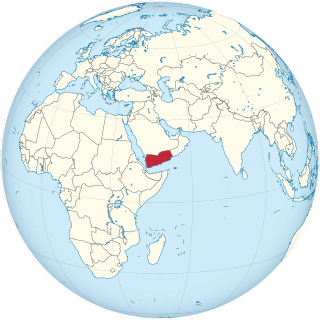
Cholera is an infection of the small intestine by some strains of the bacterium Vibrio cholerae. Symptoms may range from none, to mild, to severe. The classic symptom is large amounts of watery diarrhea that lasts a few days. Vomiting and muscle cramps may also occur. Diarrhea can be so severe that it leads within hours to severe dehydration and electrolyte imbalance. This may result in sunken eyes, cold skin, decreased skin elasticity, and wrinkling of the hands and feet. Dehydration can cause the skin to turn bluish. Symptoms start two hours to five days after exposure.

A pandemic is an epidemic of an infectious disease that has spread across a large region, for instance multiple continents or worldwide, affecting a substantial number of individuals. Widespread endemic diseases with a stable number of infected individuals such as recurrences of seasonal influenza are generally excluded as they occur simultaneously in large regions of the globe rather than being spread worldwide.

A quarantine is a restriction on the movement of people, animals and goods which is intended to prevent the spread of disease or pests. It is often used in connection to disease and illness, preventing the movement of those who may have been exposed to a communicable disease, yet do not have a confirmed medical diagnosis. It is distinct from medical isolation, in which those confirmed to be infected with a communicable disease are isolated from the healthy population. Quarantine considerations are often one aspect of border control.

An epidemic is the rapid spread of disease to a large number of hosts in a given population within a short period of time. For example, in meningococcal infections, an attack rate in excess of 15 cases per 100,000 people for two consecutive weeks is considered an epidemic.

The miasma theory is an abandoned medical theory that held that diseases—such as cholera, chlamydia, or the Black Death—were caused by a miasma, a noxious form of "bad air", also known as night air. The theory held that epidemics were caused by miasma, emanating from rotting organic matter. Though miasma theory is typically associated with the spread of contagious diseases, some academics in the early nineteenth century suggested that the theory extended to other conditions as well, e.g. one could become obese by inhaling the odor of food.

A cordon sanitaire is the restriction of movement of people into or out of a defined geographic area, such as a community, region, or country. The term originally denoted a barrier used to stop the spread of infectious diseases. The term is also often used metaphorically, in English, to refer to attempts to prevent the spread of an ideology deemed unwanted or dangerous, such as the containment policy adopted by George F. Kennan against the Soviet Union.

The third plague pandemic was a major bubonic plague pandemic that began in Yunnan, China, in 1855. This episode of bubonic plague spread to all inhabited continents, and ultimately led to more than 12 million deaths in India and China, and at least 10 million Indians were killed in British Raj India alone, making it one of the deadliest pandemics in history. According to the World Health Organization, the pandemic was considered active until 1960 when worldwide casualties dropped to 200 per year. Plague deaths have continued at a lower level for every year since.
Globalization, the flow of information, goods, capital, and people across political and geographic boundaries, allows infectious diseases to rapidly spread around the world, while also allowing the alleviation of factors such as hunger and poverty, which are key determinants of global health. The spread of diseases across wide geographic scales has increased through history. Early diseases that spread from Asia to Europe were bubonic plague, influenza of various types, and similar infectious diseases.

The first cholera pandemic (1817–1824), also known as the first Asiatic cholera pandemic or Asiatic cholera, began near the city of Calcutta and spread throughout South Asia and Southeast Asia to the Middle East, Eastern Africa and the Mediterranean coast. While cholera had spread across India many times previously, this outbreak went further; it reached as far as China and the Mediterranean Sea before subsiding. Millions of people died as a result of this pandemic, including many British soldiers, which attracted European attention. This was the first of several cholera pandemics to sweep through Asia and Europe during the 19th and 20th centuries. This first pandemic spread over an unprecedented range of territory, affecting almost every country in Asia.
The second cholera pandemic (1826–1837), also known as the Asiatic cholera pandemic, was a cholera pandemic that reached from India across Western Asia to Europe, Great Britain, and the Americas, as well as east to China and Japan. Cholera caused more deaths, more quickly, than any other epidemic disease in the 19th century. The medical community now believes cholera to be exclusively a human disease, spread through many means of travel during the time, and transmitted through warm fecal-contaminated river waters and contaminated foods. During the second pandemic, the scientific community varied in its beliefs about the causes of cholera.

The third cholera pandemic (1846–1860) was the third major outbreak of cholera originating in India in the 19th century that reached far beyond its borders, which researchers at University of California, Los Angeles (UCLA) believe may have started as early as 1837 and lasted until 1863. In the Russian Empire, more than one million people died of cholera. In 1853–1854, the epidemic in London claimed over 10,000 lives, and there were 23,000 deaths for all of Great Britain. This pandemic was considered to have the highest fatalities of the 19th-century epidemics.

The fifth cholera pandemic (1881–1896) was the fifth major international outbreak of cholera in the 19th century. It spread throughout Asia and Africa, and reached parts of France, Germany, Russia, and South America. It claimed 200,000 lives in Russia between 1893 and 1894; and 90,000 in Japan between 1887 and 1889. The 1892 outbreak in Hamburg, Germany was the biggest European outbreak; about 8,600 people died in that city. Although many residents held the city government responsible for the virulence of the epidemic, it continued with practices largely unchanged. This was the last serious European cholera outbreak of the century.

The seventh cholera pandemic is the seventh major outbreak of cholera and occurred principally from the years 1961 to 1975, but the strain involved persists to the present. WHO and some other authorities believe this should be considered as an ongoing pandemic. As stated in its cholera factsheet dated 30 March 2022, the World Health Organization (WHO) continues to define this outbreak as a current pandemic, and with cholera having become endemic in many countries. In 2017, WHO announced a global strategy aiming to end this pandemic by 2030.

The Broad Street cholera outbreak was a severe outbreak of cholera that occurred in 1854 near Broad Street in Soho, London, England, and occurred during the 1846–1860 cholera pandemic happening worldwide. This outbreak, which killed 616 people, is best known for the physician John Snow's study of its causes and his hypothesis that germ-contaminated water was the source of cholera, rather than particles in the air. This discovery came to influence public health and the construction of improved sanitation facilities beginning in the mid-19th century. Later, the term "focus of infection" started to be used to describe sites, such as the Broad Street pump, in which conditions are favourable for transmission of an infection. Snow's endeavour to find the cause of the transmission of cholera caused him to unknowingly create a double-blind experiment.

The 2008 Zimbabwean cholera outbreak was an epidemic of cholera affecting much of Zimbabwe from August 2008 until June 2009. The outbreak began in Chitungwiza in Mashonaland East Province in August 2008, then spread throughout the country so that by December 2008, cases were being reported in all 10 provinces. In December 2008, The Zimbabwean government declared the outbreak a national emergency and requested international aid. The outbreak peaked in January 2009 with 8,500 cases reported per week. Cholera cases from this outbreak were also reported in neighboring countries South Africa, Malawi, Botswana, Mozambique, and Zambia. With the help of international agencies, the outbreak was controlled, and by July 2009, after no cases had been reported for several weeks, the Zimbabwe Ministry of Health and Child Welfare declared the outbreak over. In total, 98,596 cases of cholera and 4,369 deaths were reported, making this the largest outbreak of cholera ever recorded in Zimbabwe. The large scale and severity of the outbreak has been attributed to poor sanitation, limited access to healthcare, and insufficient healthcare infrastructure throughout Zimbabwe.

Seven cholera pandemics have occurred in the past 200 years, with the first pandemic originating in India in 1817. The seventh cholera pandemic is officially a current pandemic and has been ongoing since 1961, according to a World Health Organization factsheet in March 2022. Additionally, there have been many documented major local cholera outbreaks, such as a 1991–1994 outbreak in South America and, more recently, the 2016–2021 Yemen cholera outbreak.
The second plague pandemic was a major series of epidemics of plague that started with the Black Death, which reached Europe in 1348 and killed up to half of the population of Eurasia in the next four years. Although the plague died out in most places, it became endemic and recurred regularly. A series of major epidemics occurred in the late 17th-century, and the disease recurred in some places until the late 18th-century or the early-19th century. After this, a new strain of the bacterium gave rise to the third plague pandemic, which started in Asia around the mid-19th century.

Diseases and epidemics of the 19th century included long-standing epidemic threats such as smallpox, typhus, yellow fever, and scarlet fever. In addition, cholera emerged as an epidemic threat and spread worldwide in six pandemics in the nineteenth century. The third plague pandemic emerged in China in the mid-nineteenth century and spread worldwide in the 1890s.

An outbreak of cholera began in Yemen in October 2016. The outbreak peaked in 2017 with over 2,000 reported deaths in that year alone. In 2017 and 2019, war-torn Yemen accounted for 84% and 93% of all cholera cases in the world, with children constituting the majority of reported cases. As of November 2021, there have been more than 2.5 million cases reported, and more than 4,000 people have died in the Yemen cholera outbreak, which the United Nations deemed the worst humanitarian crisis in the world at that time. However, the outbreak has substantially decreased by 2021, with a successful vaccination program implemented and only 5,676 suspected cases with two deaths reported between January 1 and March 6 of 2021.

















